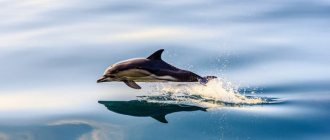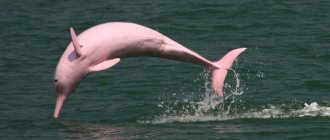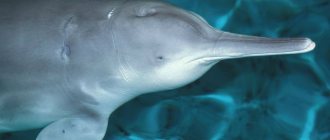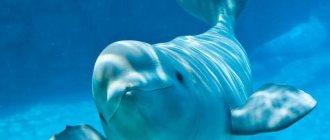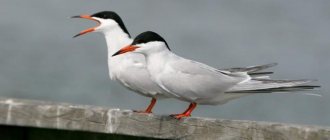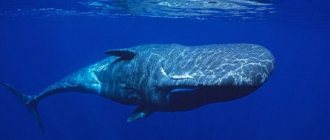- Wild animals
- >>
- Mammals
The river dolphin is a small aquatic mammal belonging to the order Cetacea.
Scientists now classify river dolphins as an endangered species because the population has declined in recent years as a result of widespread habitat degradation. River dolphins were once widely distributed throughout the rivers and coastal estuaries of Asia and South America. Today, river dolphins live only in limited parts of the Yangtze, Mekong, Indus, Ganges, Amazon and Orinoco river basins and coastal estuaries in Asia and South America.
Origin of the species and description
Photo: River dolphin
Paleontologists have made a discovery that may reveal more about the ancestor of the river dolphin, although its evolutionary origins leave many questions. Its ancestors may have abandoned the ocean for fresh water when rising sea levels opened up new habitats about 6 million years ago.
In 2011, researchers unearthed a fragmentary marine dolphin fossil that anatomical comparisons show is closely related to the Amazonian dolphin. The remains were discovered at a site along the Caribbean coast of Panama. Surviving pieces that were not lost to erosion include a partial skull, lower jaw, and several teeth. Other fossils in the surrounding rocks helped scientists narrow the dolphin's age to a range of 5.8 million to 6.1 million years.
Video: River dolphin
Named Isthminia panamensis, a mixture of the name of today's Amazon River dolphin and the location where the new species was found - a dolphin measuring approximately 2.85 meters in length. The shape of the 36cm head, which faces straight rather than slightly downward like modern river dolphins, suggests the mammal spent most of its time at sea and likely fed on fish, the scientists said.
Based on the anatomical features of the fossil, Isthminia was either a close relative or ancestor of the modern river dolphin. There is also a current theory that the species found was the descendant of an older and as yet undiscovered river dolphin that returned to the sea.
Binoculars…
One slow southern day I noticed a strange man on the beach. Tanned, red swimming trunks, a white scarf on his head. An ordinary vacationer, if not for the huge marine binoculars, through which he looked at the expanses of the Black Sea from a flat rock hanging over the water. I mistook him for a lifeguard and, somehow finding myself next to him in a coastal cafe, nodded at his binoculars and asked: “And how is the situation at sea? Are they drowning?
The man laughed and replied that he was not a lifeguard, but came to the sea because he loved dolphins very much, knew everything about them, and that since last year he had several familiar bottlenose dolphins swimming in these waters. And he told me about the dolphins of the Black Sea. How surprised I was! It turns out that there are people who come to the resort not only for a “lazy” holiday along the “hotel - beach - restaurant - hotel” route, but for completely different purposes...
Months have passed since then. The passion of my southern friend, his fanaticism and love for dolphins resonated with me - I read a lot about these amazing creatures, learned a lot, and already bought good binoculars. Do you know why?..
Appearance and features
Photo: River dolphin animal
There are currently four species of river dolphin:
- The Amazon river dolphin is a fairly robust animal with small eyes and a long, thin mouth that is slightly curved towards the tip. They are the only toothed whales whose teeth are differentiated in the jaw, the front being the usual simple conical shape, while the back is designed to aid in crushing prey items. The crescent-shaped hole is located left of center on the head, the neck is very flexible due to the non-fused cervical vertebrae and has a distinct crease. The Amazon River dolphin has a very low dorsal fin. The flippers are triangular, wide and have blunt tips. One of the most striking characteristics of this species is its coloration, ranging from white/gray to pink. Some individuals, however, are bright pink;
- Baiji is a freshwater dolphin found only in the Yangtze River. This species is pale blue or gray in color and white on the ventral side. It also has a low, triangular dorsal fin, a long, upturned mouth, and very small eyes set high on the head. Due to poor eyesight and the murky waters of the Yangtze River, the baiji rely on sound to communicate;
- The Ganges River dolphin has a strong and flexible body with a low, triangular dorsal fin. Weighs up to 150 kg. Juveniles are characterized by brown color at birth and become greyish-brown in adulthood with smooth and hairless skin. Females are larger than males. The maximum length of the female is 2.67 m, and the male - 2.12 m. Females reach sexual maturity at the age of 10-12 years, while males mature earlier;
- The La Plata dolphin is known for its extremely long mouth, which is considered the largest of all known dolphin species. On average, representatives of this species reach 1.5 meters in length and weigh about 50 kg. The dorsal fin is triangular in shape with a rounded edge. In terms of color, these dolphins have a grayish-brown skin tone with lighter coloring on the belly.
Notes
- Complete illustrated encyclopedia. "Mammals" Book. 1 = The New Encyclopedia of Mammals / ed. D. MacDonald. - M.: Omega, 2007. - P. 219. - 3000 copies. — ISBN 978-5-465-01346-8.
- ↑ Sokolov V. E.
Five-language dictionary of animal names. Mammals. Latin, Russian, English, German, French. / under the general editorship of academician. V. E. Sokolova. - M.: Rus. lang., 1984. - P. 112. - 10,000 copies. - Tomilin A.G. Order Cetacea (Cetacea) // Animal Life. Volume 7. Mammals / ed. V. E. Sokolova. — 2nd ed. - M.: Education, 1989. - P. 371. - 558 p. — ISBN 5-09-001434-5
- Biological encyclopedic dictionary / Ch. ed. M. S. Gilyarov; Editorial team: A. A. Baev, G. G. Vinberg, G. A. Zavarzin, etc. - M.: Sov. encyclopedia, 1986. - pp. 539-540. — 831 p. — 100,000 copies.
- Sokolov V. E. Systematics of mammals. Volume 3. Cetaceans, carnivores, pinnipeds, aardvarks, proboscideans, hyraxes, sirens, artiodactyls, callouseds, odd-toed ungulates. - M.: Higher School, 1979. - P. 19. - 528 p.
- Sokolov V. E.
Rare and endangered animals. Mammals. - M.: Higher School, 1986. - P. 227. - 100,000 copies. - Sokolov V. E. Fauna of the world: Mammals: Directory. - M.: Agropromizdat, 1990. - P. 125. - 254 p. — ISBN 5-10-001036-3
Where do river dolphins live?
Photo: Pink river dolphin
The Amazon dolphin is found in the Orinoco and Amazon river basins, in the bases of rivers, their tributaries and lakes, although in some places its natural range is limited by development and dam construction. During the monsoon season, habitats extend to flooded forests.
Baiji, also known as the Chinese Yangtze River Delta dolphin, is a freshwater dolphin. Baiji are usually found in pairs and can form large social groups of 10 to 16 people. They feed on a variety of small freshwater fish, using their long, slightly raised mouth to explore the muddy Chinese river bottom.
WWF-India has identified optimal habitats at 9 sites in 8 rivers for the Ganges River dolphin population and hence for priority conservation actions. These include: Upper Ganga (from Brijhat to Narora) in Uttar Pradesh (a proposed Ramsar site), Chambal River (up to 10 km downstream of Chambal Wildlife Sanctuary) in Madhya Pradesh and Uttar Pradesh, Ghagra and Gandak river in Uttar Pradesh and Bihar, Ganga river, from Varanasi to Patna in Uttar Pradesh and Bihar, Son and Kosi river in Bihar, Brahamaputra river in Sadia district (foothills of Arunachal Pradesh) and Dhubri (Bangladesh border), Kulsi and a tributary of the Brahamaputra.
The La Plata dolphin is found in the coastal waters of the Atlantic in southeastern South America. Some of the most common areas in which they can be found include the coastal waters of Argentina, Brazil and Uruguay. There have been no significant studies confirmed regarding migration, but the small amount of data from dolphins strongly suggests that migration does not occur outside their coastal zone.
Amazonian inia, or buto
(Inia geoffrensis
). Young animals are light gray, but with age they gradually acquire a pinkish tint. Their very long snout is covered with stiff hairs or bristles, which apparently serve a sensory function. Amazon hoarfish have an average of 25–27 teeth on each side of each jaw. The front teeth are pointed, conical, and the back teeth are somewhat similar to molars. Two types of teeth and unfused cervical vertebrae are primitive features for cetaceans. Inia feeds on fish, including those covered with bony plates, and its teeth are often heavily worn, apparently from chewing hard food.
According to some reports, inia may have several subspecies. These freshwater cetaceans are common in the Amazon and Orinoco river basins and during floods they even penetrate into flooded forests, where they swim between the trees. When searching for food on the bottom, inias often turn belly up, perhaps because their thick cheeks would otherwise obstruct their view. Studies of the sounds they make have shown the presence of a rich repertoire of pulse signals, including echolocation signals, used to search for food and explore the environment; however, no monotonal whistles were detected.
What do river dolphins eat?
Photo: Freshwater dolphin
Like all dolphins, river dolphins feed on fish. Their menu includes about 50 species of small freshwater fish. River dolphins often hunt by poking with their long, slightly curved mouths among the branches of sunken trees that litter the river bottom.
All dolphins find food using echolocation or sonar. This method of communication is especially important for river dolphins when hunting, because visibility in their dark habitats is extremely poor. The river dolphin finds fish by sending high-frequency sound pulses from the top of its head. When these sound waves reach the fish, they travel back to the dolphin, which senses them through the long jaw bone, which acts almost like an antenna. The dolphin then swims up to grab the fish.
Most of the fish in the river dolphin's diet are very bony compared to ocean fish. Many have tough, almost "armored" bodies, and some even protect themselves with sharp, tough spines. But this protection cannot compare with the freshwater dolphin’s powerful jaw and “armor-piercing” teeth. The teeth on the front of the jaw are designed to pierce and hold even the toughest catfish; the teeth at the back form an excellent and merciless crushing tool.
Once the fish is caught and crushed, the dolphin swallows it without chewing it. It may later spit out spine bones and other indigestible parts of the prey. Observations indicate that communal feeding is widespread, suggesting that some dolphins may hunt together for food.
Lifestyle
Ecology is practically not studied. They stay at the mouths of tributaries, near islands and in shallow, muddy water, where vision is practically useless. Therefore, these dolphins have very poor vision and rely mainly on echolocation. In the Yangtze, lake dolphins swim into shallow waters only to hunt fish. In terms of lifestyle, the river dolphin is close to the Indian. Their lifestyle is diurnal; at night they rest in areas with slow currents. It feeds mainly on small fish, in particular eels and catfish, which it digs out of the bottom silt with its long beak, as well as mollusks. Dives for only 10-20 seconds. It crushes mollusk shells with its strong teeth, which have lateral outgrowths on the wide roots. River dolphins are usually found in pairs, which sometimes merge into groups of 3-16 individuals, staying in feeding areas for 5-6 hours. A wounded dolphin makes a sound similar to the cry of a buffalo calf. Seasonal migrations were noted: to Lake Dongting in late autumn, during the rainy season, dolphins migrated from the lake up the rivers flowing into it; in the Yangtze in the summer, when the water was high, they swam into small channels, returning to the main channel of the river in the winter. The longest recorded migration was over 200 km. By nature, the river dolphin is secretive and timid.
Reproduction
Reproduction is practically not studied. Apparently it is seasonal. Peak breeding occurs between February and April. Pregnancy is expected to last up to 11 months. The female brings one cub 80-90 cm long once every 2 years. It is known that lake dolphin calves are very weak and practically cannot swim, so at first the female holds them with flippers, which has also been observed in a number of other cetaceans. The duration of lactation is unknown; Dolphins reach sexual maturity between 3 and 8 years. Life expectancy is unknown.
Features of character and lifestyle
Photo: River dolphin
River dolphins are friendly creatures that have lived in fresh waters for centuries. Typically seen alone or in pairs during mating season, these dolphins quite often gather in groups of 10 to 15 individuals when there is ample prey available. Like most other species, these dolphins sleep with one eye open.
Typically, these creatures are slow swimmers and mostly diurnal. River dolphins are active from early morning until late evening. They breathe using their dorsal fins and mouth at the same time.
River dolphins are rarely seen jumping above the surface of the water. However, Amazon dolphins, for example, often swim belly up. The reason for this behavior is still unclear. It is believed that the voluminous cheeks of these dolphins act as an obstruction to their vision, causing these dolphins to roll over in order to see the bottom.
Interesting facts about the animal
Little is known about this representative of river and lake waters. But there are still some facts that deserve attention. Did you know that:
- the breathing of a mammal is similar to a loud sneeze;
- because of the special shape of the muzzle, these inhabitants of the river depths were called “river pigs”;
- They are also called “Yangtze panda”;
- this representative of cetaceans is capable of diving for a short time - up to 20 seconds;
- according to Chinese legend, the lake dolphin is the spirit of a princess who was drowned in ancient times because she refused to marry someone she didn’t love;
- the only animal that managed to adapt in captivity lived 24 years;
- it took humanity less than 100 years to completely exterminate the population; This is due to the fact that about 10% of the world’s population lives in the habitat.
Dolphins are very smart and mysterious animals. They, like all the inhabitants of our planet, deserve human protection and careful treatment!
Social structure and reproduction
Photo: Animal river dolphin
River dolphins often play together. This is a well-known behavior for whales. However, scientists later discovered that only males play during the mating season. If a female dolphin is sexually mature, she can only attract one male. Thus, there is a lot of competition between males. In their mating games, they sometimes throw aquatic plants around them. The best male players receive the most attention from females.
It was recently discovered that river dolphins live alone most of the time. Females become sexually mature at the age of seven years. The gestation period (the period from conception to birth) lasts 9 - 10 months.
Although breeding can occur at any time of the year, the earlier months are most fertile. However, a birth that occurs underwater has never been observed by scientists. Immediately after birth, other females push the calf to the surface of the water so that it begins to breathe.
After birth, the female may continue to nurse the calf for up to 12 months, although observations indicate that on average, dolphins usually separate from their mother after just a few months. The average lifespan of river dolphins is 30 years.
Human interaction
This species was first discovered in 1918 in the Chinese province of Hunan in Lake Dongting. By the 50s of the last century, the dolphin population numbered about 6 thousand specimens.
After 30 years, their number rapidly dropped to several hundred. By 1997, only 13 of them remained. In 2006, it was announced that all existing individuals were extinct.
Since 1975, the endangered species has been protected by the PRC; hunting for it was banned only in 1983. Already in 1992, a reserve was created where dolphins were kept.
However, an attempt to reproduce in captivity was unsuccessful: the last individual caught in Lake Dongting lived until 2002. The lives of the other two individuals lasted one month and one year, respectively.
Natural enemies of river dolphins
Photo: Chinese river dolphin
The main threat to the river dolphin is targeted hunting, where animals are used either as bait or are considered by fishermen as competitors. Other threats to the species include human disturbance, entanglement in fishing gear, prey shortages and chemical pollution. River dolphins are considered endangered on the IUCN Red List.
River dolphins are under serious threat due to widespread habitat degradation caused by pollution, deforestation, dam construction and other destructive processes. Chemical pollution from urban, industrial and agricultural waste and runoff weakens river dolphins' immune systems, leaving the animals vulnerable to infectious diseases.
Noise influence disrupts the ability to navigate. Deforestation reduces the number of fish in rivers, depriving river dolphins of their main prey. Deforestation also changes rainwater runoff patterns, often causing river levels to drop. Lower water levels draw river dolphins into drying pools. River dolphins are often struck by logs that logging companies transport directly down rivers.
Overfishing has led to a decline in the world's rivers and oceans, putting river dolphins in direct competition with humans for food. River dolphins often become caught in nets and fishing hooks, or are stunned by explosives used to catch fish.
Population and species status
Photo: River dolphin
All river dolphins use a sophisticated echolocation system to identify mates and prey. In the past, river dolphins and humans coexisted peacefully along the Mekong, Ganges, Yangtze and Amazon rivers. People have traditionally shared the fish and water of rivers with river dolphins and included river dolphins in myths and stories. These traditional beliefs have helped river dolphins survive. However, today people sometimes do not respect the prohibitions against harming river dolphins and kill the animals in large numbers.
Dams and other destructive processes in rivers affect river dolphins by reducing fish numbers and reducing oxygen levels. Dams often reduce flows by trapping fresh water in their reservoirs and irrigation canals. Dams also divide the river dolphin population into small and genetically isolated groups that become highly vulnerable to extinction.
Dams alter the environment, causing rivers to undergo major changes. This phenomenon reduces the likelihood of the formation of preferred habitats for river dolphins. Destructive structures such as pumping stations and irrigation projects negatively impact river dolphin habitat and affect the animals' ability to reproduce and survive.
However, despite people recognizing the endangered status of river dolphins and making conservation efforts, the animals' numbers continue to decline worldwide. In many cases the reduction is critical. Some individuals are losing the genetic variation needed to survive short- and long-term threats, including climate change and prey shortages.

